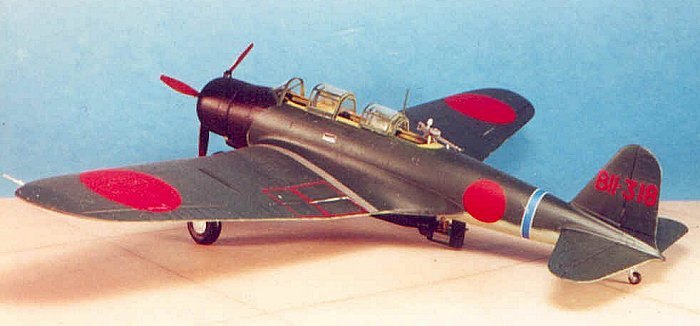
|
KIT: |
Hasegawa 1/48 B5N2 'Kate' |
|
KIT # |
9076 |
|
PRICE: |
$29.98 |
|
DECALS: |
See Review |
|
REVIEW & |
|
|
NOTES: |
|

|
HISTORY |
The Nakajima B5N2 Type 97 Carrier Attack Bomber came as a nasty surprise to the U.S. Navy at the Battle of the Coral Sea, nearly five months after it was first used at Pearl Harbor. Wildcats and Dauntlesses flying the inner patrol line at an altitude of 1,500 feet - in their experience plenty of altitude to pick up speed and knock off enemy torpedo bombers - watched in stunned amazement as the Japanese strike aircraft sailed 2,000 feet overhead in a dive, at a speed high enough that those few Wildcats who had been further out at higher altitudes had trouble keeping up with the enemy. At four times the distance U.S. Navy Devastators would be dropping their torpedoes from an altitude of one hundred feet and airspeed of one hundred miles an hour, the Japanese dropped their deadly "Long-Lance" torpedoes from an altitude of nearly 2,000 feet and an airspeed of over 200 miles per hour. Both American aircraft carriers maneuvered wildly to avoid the high speed weapons; the "Lexington" proved unlucky that day as it took the hits that would later seal its doom.
The "Lexington" was only the most recent victim of the airplane the Navy knew as "Kate," since it had been responsible for the majority of U.S. naval losses in the Pearl Harbor attack, including the U.S.S. "Arizona," which was sunk by a single 1,600 pound bomb dropped by a B5N2 operating in its alternative high-altitude level bomber role, which penetrated to the forward magazine.
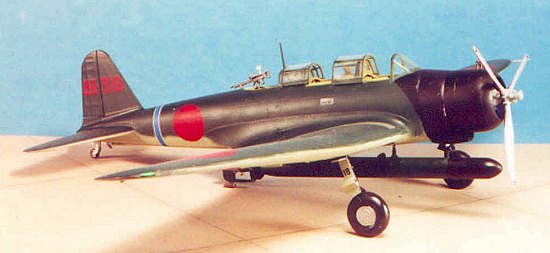 The U.S. Navy was
completely unaware that the Imperial Japanese Navy had been operating the
world's most advanced torpedo bomber for more than two years by the time of
Coral Sea. A month later at Midway, having learned their lesson, the Americans
would defend further out and at higher altitude, but in all four of the great
carrier battles fought in 1942, (including Eastern Solomons in late August and
Santa Cruz that October) the airplane the Navy came to call the "Kate"
was a dangerous and deadly foe; if it got past the defensive fighters, the only
hope for the carriers was that the anti-aircraft defense of their escorting
warships would shoot them out of the sky before they could drop their torpedo.
The U.S. Navy was
completely unaware that the Imperial Japanese Navy had been operating the
world's most advanced torpedo bomber for more than two years by the time of
Coral Sea. A month later at Midway, having learned their lesson, the Americans
would defend further out and at higher altitude, but in all four of the great
carrier battles fought in 1942, (including Eastern Solomons in late August and
Santa Cruz that October) the airplane the Navy came to call the "Kate"
was a dangerous and deadly foe; if it got past the defensive fighters, the only
hope for the carriers was that the anti-aircraft defense of their escorting
warships would shoot them out of the sky before they could drop their torpedo.
As with most Japanese aircraft at this time, the B5N2 achieved this startling performance by the omission of such things as armor for the crew and self-sealing fuel tanks considered standard fit in western air forces. This was due to the relatively low power of Japanese engines at the time. The 3-man "Kate" used the same Sakae engine as the Model 21 "Zero," and that was a big improvement on the engine the B5N1 first flew with in 1938. With a defensive armament of only a single Lewis gun in the rear, the airplane was easy pickings for any heavily-armed U.S. fighter that could catch it; as a level bomber attacking at Guadalcanal, the airplane was shot down in droves. By the end of the first phase of the Pacific War the B5N2 was essentially obsolete, yet it would be forced to carry on almost till the end of the war due to the difficulties encountered in bringing its replacement - the B6N "Tenzan" - to operational status.
|
THE KIT |
Prior to the release of this new kit by Hasegawa, the only kit available in 1/48 was that released in the 1970s by Nichimo. At the time of its release, the kit was in advance of the state of the art as regards surface detail, and it can still be turned into an outstanding model with some effort by the modeler as regards the cockpit interior. If your time is worth money at all, the Hasegawa kit can even be considered a bargain despite its higher cost, in the time not spent scratchbuilding a cockpit that will not be one-tenth as good as that which is supplied in the new kit. Since the release of the B6N and B7N two years ago, Hasegawa's kit-supplied cockpit interiors have gotten better and better as exemplified in the Ki.84 "Hayate" and N1K2-J "Shiden-Kai," and this is continued here. The canopy comes in two versions: a single-piece closed canopy, or separated sections that can be stacked open. Due to the relative thickness of even this thin clear plastic, these parts are not completely accurate, but the end result looks good. The Squadron vacuform canopy for the Nichimo kit does not fit this kit; I would hope a vacuform canopy for the newer kit will be released soon.
Decals supplied in the kit include markings for the B5N2 flown by LCDR Fujita, the air commander of the first wave attack at Pearl Harbor. There are also sufficient tail ID letters and numbers to do Kates from any of the main carriers of the Combined Fleet. The kit supplies only the heavy bomb - made from a 16-inch gun shell - that was carried by the level bombers in the Pearl Harbor attack. There will of course be a later release of the torpedo bomber version.
|
CONSTRUCTION |
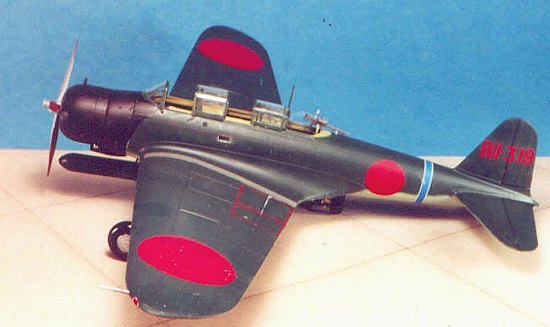 The kit is extremely
well-designed and goes together very well. I started with the cockpit, which I
painted a light tan, rather than "Nakajima green," since this was what
the hon-chos over at www.j-aircraft-com had determined was the proper
color. I don't know if this is the exact accurate shade, but it seems to be from
the descriptions I read at the message board. (Editors Note: It could also be
painted in what is known as 'Bamboo' a rather greenish yellow color that was
carried by Aeromaster. Much of Japanese interior color info is a mystery to
most modelers as there is little on the subject published in English.
Thorpe's books are over 30 years old and much has been shown to be inaccurate
over the years.) With only a bit of detail painting, use of the decal
instrument panels, and the addition of lead foil seat belts, the cockpit was
finished.
The kit is extremely
well-designed and goes together very well. I started with the cockpit, which I
painted a light tan, rather than "Nakajima green," since this was what
the hon-chos over at www.j-aircraft-com had determined was the proper
color. I don't know if this is the exact accurate shade, but it seems to be from
the descriptions I read at the message board. (Editors Note: It could also be
painted in what is known as 'Bamboo' a rather greenish yellow color that was
carried by Aeromaster. Much of Japanese interior color info is a mystery to
most modelers as there is little on the subject published in English.
Thorpe's books are over 30 years old and much has been shown to be inaccurate
over the years.) With only a bit of detail painting, use of the decal
instrument panels, and the addition of lead foil seat belts, the cockpit was
finished.
While this was setting up, I assembled the wing, which also went together well. I then glued the cockpit in place in the fuselage and glued the fuselage halves together. The wing attached with no problem, as did the horizontal stabilizers, and I did not use any putty on the model anywhere. I only used Mr. Surfacer on the fuselage center seams, which disappeared under a light coat and a light sanding.
Since I had the old Nichimo kit, I decided I would use the torpedo from that on this model, to make one of the B5N2s from "Shokaku" that fought so well at the Battle of the Coral Sea. I had opened all three of the attachment holes in the lower wing center section for the torpedo racks.
I painted the engine and cowling interior, assembled it and attached it to the model, which was now ready for painting.
|
PAINT & DECALS |
Painting:
After "pre-shading" the model with flat black along all the panel lines, I painted the cowling and forward fuselage area flat black. When it was dry, I masked it off. I then painted the wheel wells and interior of the gear doors with Model Master non-buffing Aluminum, sealed it, then shot Gunze-Sanyo "Clear Blue" for the "Aotake" color in these areas. With all this masked off, I then shot Tamiya "IJN Grey" for the lower surface camouflage. I used Tamiya "IJN Green" - which has been determined to be a close match for "Nakajima exterior green" (the Gunze-Sanyo "IJN Green" is a good match for "Mitsubishi exterior green"). After everything had dried, I unmasked the forward fuselage and gave the model a coat of Future.
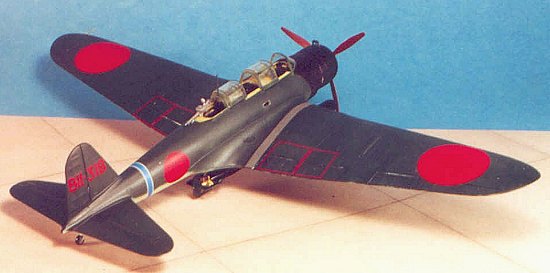 Decals:
Decals:
I used the kit decals, which went down well under several applications of Micro-Sol and a final coat of Solvaset - which is my standard application to Hasegawa decals due to their thickness. I used a photo of a Kate aboard Shokaku to get the tail ID.
Final Finish and Assembly:
When the decals were all dry, I washed the model to get rid of dried-on decal solvent, then gave it another coat of Future, which was then followed by several coats of my "Flat Future" mixture. I did not want a fully-flat finish, as these airplanes started their life with a gloss finish; I wanted a "semi-gloss/semi-flat" finish which would be the result of exposure to sea air. Since the airplane was carrier-based and subject to excellent care and maintenance, I did not weather it beyond a few "dings" along the wing walk and some exhaust staining.
I then attached the landing gear, propeller and canopies in the open position. When I attached the Nichimo torpedo to the racks, it was immediately apparent that the tail was too big, since it would drag on the ground. I took a look at some photos, and trimmed off about 1/16" from the longer vertical fin, then cut the tips at an angle. There wasn't a lot of clearance for the torpedo, but this was not a problem as the airplane was taking off from a carrier deck.
|
CONCLUSIONS |
This is another winner from Hasegawa, and a definite "must have" for those interested in the airplanes of the Japanese Navy in the Pacific War. It's the kind of kit that can make a good modeler look great, with its ease of assembly and overall thoughtful kit design.
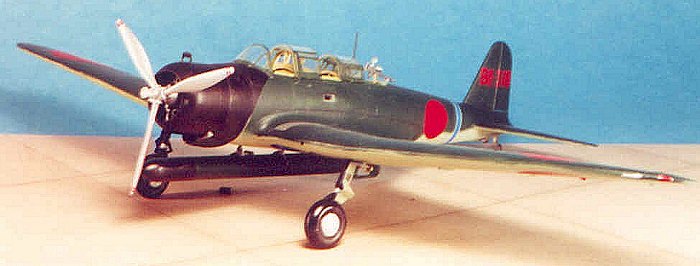
Review kit courtesy of Marco Polo Imports. Thanks for your support
If you would like your product reviewed fairly and quickly by a site that averages over 2,200 visits a day, please contact me or see other details in the Note to Contributors.